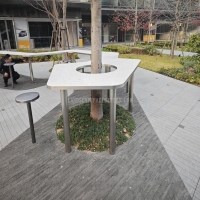Welcome to the website for landscape facilities products and knowledge.
What are the key factors in determining the table’s resistance to warping or bending?
The stability and flatness of a table are crucial for both functionality and aesthetics. Understanding what causes warping and bending is essential for selecting durable furniture. Several key factors determine a table's resistance to these deformations.
Material selection stands as the primary consideration. Solid wood, while beautiful, is inherently hygroscopic, meaning it absorbs and releases moisture from the air. This movement is the primary cause of warping. Woods with a straight, tight grain pattern and those that are properly kiln-dried, like quarter-sawn oak or maple, are generally more stable. Engineered woods like plywood, MDF, and particleboard are manufactured to resist warping, as their layered or composite structure counteracts the natural tendency of wood to move. The material's thickness also plays a role; thicker slabs are more resistant to bending under load but can still warp if internal stresses are not balanced.
Construction techniques are equally critical. The method used to join the tabletop planks is paramount. Using breadboard ends, which are perpendicular pieces attached with a specialized sliding mortise-and-tenon joint, can effectively prevent cupping across the width of a table. Similarly, attaching the tabletop to the base or apron using flexible fasteners (like figure-8 clips or slotted metal brackets) instead of rigid screws allows the wood to expand and contract seasonally without cracking or twisting the entire structure. The orientation of the wood grain in laminated sections must also be alternated to counteract the pulling forces of adjacent pieces.
Environmental controls are a constant factor. Consistent humidity levels are the nemesis of wood warping. Rapid or extreme changes in relative humidity cause wood to absorb or lose moisture unevenly, leading to swelling, shrinking, and distortion. Maintaining a stable environment between 40-60% relative humidity is ideal for wooden furniture. Furthermore, protecting the table from direct sunlight and heat sources prevents one side from drying out faster than the other, a common cause of warping.
Finally, the design and engineering of the table's understructure provide fundamental support. A sturdy apron or a well-designed base with adequate cross-bracing significantly reduces the risk of the tabletop sagging or bending over time, especially in longer spans. The leg attachment must be robust to prevent racking, which can also lead to misalignment and stress on the tabletop. For a table to remain flat and true, a holistic approach that combines the right material, expert construction, a stable environment, and a sound structural design is indispensable.
Related search:

Recommendation
An outdoor bar counter with stainless steel and terrazzo materials in an irregular shape